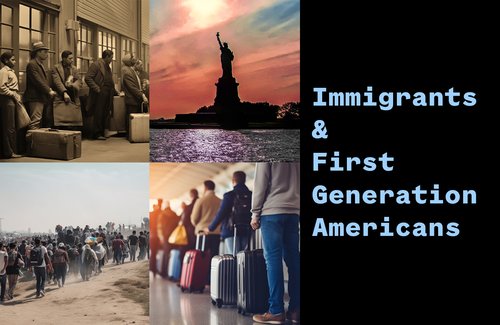
Explore the experiences of immigrants or first-generation citizens of your country. What does it mean to fit in and feel like a citizen?
If you’re not an immigrant or first-generation, find someone who is willing to share about their experiences.
First-generation people were born in your country but have parents who were born elsewhere, while immigrants moved here from another country. If you or your parents were born in another country, how do you stay connected to more than one culture?
Since 1990, “the number of international migrants has risen sharply,” according to the United Nations Department of Economic and World Affairs.
Talk to your friends, family, and people in your community. For inspiration, check out I trekked across Europe so I could go to school safely, or this story about a young immigrant working to become an attorney, made by student journalists in Washington DC.
Fitting in:
Culture and language:
Family
This resource is part of the Global Education Toolkit and was made possible with support from the Longview Foundation.
Journalism is the activity of gathering, assessing, creating, and presenting news and information.
A subject or problem that people are thinking and talking about
A group of people who live in the same area (such as a city, town, or neighborhood). It can also be a group of people who have the same interests, religion, race, etc.
In news media, when storytelling presents a “frame” or window into important events or topics.
A simplified and standardized conception or image invested with special meaning and held in common by members of a group; a set form or convention
The condition of having or being composed of differing elements. Especially in the context of the inclusion of people of different races, cultures, etc. in a group or organization
The act or practice of including and accommodating people who have historically been excluded (as because of their race, gender, sexuality, or ability)
Awareness of the elements of environment through physical sensation or intuitive cognition. A capacity for comprehension and understanding.
People are interested in other people. Everyone has something to celebrate and something to complain about. We like unusual stories of people who accomplish amazing feats or handle a life crisis because we can identify with them.
In news, it’s a story’s point or theme. It's the lens through which the producer or writer filters the information they have gathered and focuses it to make it meaningful to viewers or readers.
The people who read, watch and consume news. Often, journalists think about audience and newsworthiness in similar ways. How will the news story serve their local or national audience? Who am I writing the story for and why?
A person or other physical being in a narrative. Stories are made up of different characters who provide information and help shape the narrative with their knowledge, experience and perspective.
A description of what your story might be and WHY it’s important. An outline of your story idea and the steps to achieve your goal. A summary of what you hope to accomplish in your story
Video stories about newsworthy issues and topics, factual information, balanced reporting, research, voice overs, soundbites, b-roll footage, infographics, reporter standup, nats (natural sound bites).
The story of one person, has voiceover (VO), b-roll, pictures, nats (natural sound), interviews of family members or peers of that one person.
Narration and/or voiceover (VO) with a host, commentary, research, personal experiences, explanations, infographics, nats (natural sound), music, entertainment.
An investigation into and study of sources in order to establish facts and reach new conclusions.
Free from mistake or error. Coverage of topics and facts in appropriate detail.
Determine the kinds of sources that will be helpful in answering compelling and supporting questions, taking into consideration multiple points of view represented in the sources, the types of sources available, and the potential uses of the sources. (NCSS D1.5.9-12)
Students leverage technology to take an active role in choosing, achieving and demonstrating competency in their learning goals, informed by the learning sciences. (ISTE)
Whether students are constructing opinions, explanation, or arguments, they will gather information from a variety of sources and evaluate the relevance of that information. (NCSS D3.1.9-12 - D3.2.9-12)
Historical understanding requires recognizing this multiplicity of points of view in the past, which makes it important to seek out a range of sources on any historical question rather than simply use those that are easiest to find. It also requires recognizing that perspectives change over time, so that historical understanding requires developing a sense of empathy with people in the past whose perspectives might be very different from those of today. (NCSS D2.His.4.9-12 - D2.His.8.9-12)
Journalism
Representation
Stereotypes and Misconceptions
Civics
History
Active Prompts
Beginner
Intermediate
Computers
Internet
4-6 weeks